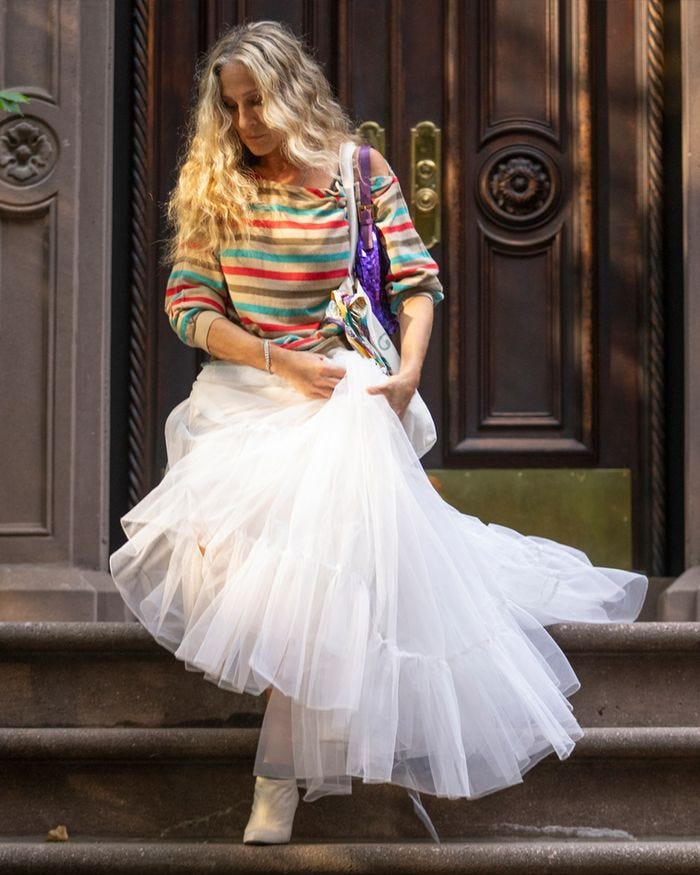Are People TRULY More Dressed-Up These Days?
The fashion industry claims yes but I'm skeptical.
Thank you for subscribing to Back Row. This issue is free to read but this newsletter is made possible by paying subscribers. For $5 a month or $50 a year, get access to around two posts a week and the full Back Row archive, including this week’s post of fashion predictions for 2023, commenting and — making its debut at the bottom of this issue — poll responding! Your subscriptions support a new business model for fashion journalism, which allows me to work for you instead of advertisers.
You’ve probably come across a story or two about how dressed up everyone is now that pandemic restrictions have been lifted. In May, CNBC proclaimed in a headline, “Glam makeup and dressing are back.” Citing retailers like Macy’s, Urban Outfitters, and Ulta Beauty, the story reported, “People are paying to look their best as they leave the house again.” Recent reports in The Zoe Report and Vogue called sparkles and metallics, respectively, “a trend with a strong track record of staying in the zeitgeist” and a “fashion must-have.” Business of Fashion recently ran an enjoyable, well-reported story with the headline, “Why Sequins and Platform Heels Are Here to Stay,” citing compelling retail data and anecdotal evidence that the market for occasion wear is doing remarkably well.
Reading some of these stories, though, one might come away with the idea that everyone is out there dressing like Carrie Bradshaw to do something as mundane as walk the dog or grab a latte. Like, “I don’t feel like making coffee today, let me throw on my crinoline and stilettos for the 20-minute trip to Blue Bottle. Come on, Tinkerbell, let’s grab your Valentino Barbiecore rockstud collar, I’M FINALLY LEAVING THE HOUSE DON’T DRAG ME DOWN NOW.”
But I’m skeptical that this is really what’s happening. I think there is a difference between pent-up demand for formalwear for true occasion dressing (meaning, a wedding, a black tie fundraiser, a bachelorette party) and the day-to-day clothing needs of the masses which the pandemic has likely casualized, so to speak, faster than time naturally would have otherwise.
The way we dress day-to-day has only become more casual over time, as history shows. If you were a woman in 1897, you might be reading this while wearing a corset with whalebone stays. Now, never mind the whalebone stays, the act of just wearing a dress every day probably sounds wild to many of us.
Workwear itself — which dictates the daily needs of many shoppers — has become increasingly casual since the eighties, which thrust office goers into power suits and shoulder pads. In the nineties, designers like Donna Karan softened silhouettes, giving way to business casual. But the tan slacks and open-collared shirts Jeff Bezos wore in the earliest photos of him running Amazon were nothing compared to the “come as you are” casual workwear revolution that tech companies would impose upon offices across industries.
By the aughts, business casual became the norm, with jeans becoming an acceptable part of the equation. In the 2010s we traded our heels for sneakers, but many of us were motivated to dress — pardon the horrible expression — “for the ‘gram” in statement outfits (remember arm parties? ripped jeans and lattes? millennial pink?). Now, people are increasingly less motivated to do much of anything for, what, exactly? The Reel? Apparently you can be lazy as hell and still earn a boatload of money from making those.
Dressing down was picking up even before the pandemic. In 2019, Goldman Sachs CEO David Solomon instituted a “firmwide flexible dress code” that was supposed to free employees from suits and ties. It was probably designed to make banking jobs as enticing to potential talent as tech ones, but it was still a big step toward the demise of formal work clothes. After this cohort went back to the office late last year, the New York Times interviewed them about their Brookfield Place street style, and they said they were “a little less dressy than before.” While they still wear labels like Suit Supply, at least one dude interviewed was wearing Lululemon office pants.
I think we’re seeing two things drive the dressy clothing sales boom: one, events that were canceled during the pandemic like weddings are going forward; and two, people who didn’t spend as much as usual on things like travel and clothing during the pandemic have the budget to really go for it now that they have something to go to. That’s it.
From that Business of Fashion story:
“Occasion dressing has become a more normalised behaviour, whether it’s out to lunch or for a bridal shower,” said Jodi Kahn, vice president, luxury fashion, at Neiman Marcus Group. “You’re a little bit more dressed up than in 2019 … it’s definitely a shift in mindset.”
I respectfully disagree with Kahn on this point (and I welcome your disagreement with me in the comments). I don’t think women who used to reach for sneakers are reaching for heels. I don’t think women who used to throw on jeans are now choosing a crocheted sequined skirt or metallic pants. I think the average mindset has permanently shifted to hyper-casual dressing and that this was inevitable but hastened by the pandemic. I interviewed around a dozen people across the country this past spring about what they’d be wearing back to the office for a Fast Company story, and the predominant sentiment was that they were dressed down. That their “career pants” were packed up collecting dust in a storage bin in the closet. Even a corporate lawyer who used to wear suits and Max Mara dresses to the office told me that she was consigning her designer clothes (with some sadness because, you know, Max Mara) because her office now permitted jeans.
I did a quick poll of friends with different work situations (self-employed, back to an office, working from home) and none said that they were dressing up more day-to-day, be it to go to a workplace or just eat salmon inside a restaurant. One told me she’s dressing the same “presentable” way for the office she did before lockdown. Another told me she hates jeans and bought “trousers” as an alternative. She also noted that although skinny jeans are out, flares haven’t caught on because people don’t know how to style them, which I think is true — and which might leave many shoppers in sweats and leggings.
I’m not the ideal case study on pandemic dressing since I worked from home for a couple of years before it hit, but I did wear my old office clothes more often than I do now for meetings and events. Now, my closet is a veritable graveyard of shift dresses. I have a black leather one that’s so dusty I could probably write RIP on it with my fingertip. If a bat has moved into one of my blazers and been nesting there silently for two or three years, I wouldn’t know.
But there’s always the possibility that the people in my texts and I are just “old,” right? (Old in the fashion sense, not the actual sense.) However, I have young kids and am therefore around Gen Alpha (the Gen right behind Z) all the time. And none of them want to even wear jeans. I live near a school for grades seven through twelve and I see the kids walking around my neighborhood every day and they don’t wear jeans, either. Millennials like me probably grew up in jeans, but these kids almost exclusively wear sweats, leggings, and track pants. A mom in Austin, Texas (where I’m from) told me that some kids there only ever wear shorts, even on freak cold days, and jeans are seldom seen unless the kids need to look “nice.”
I asked Edited, a firm that tracks retail sales, how the kids’ athleisure market is doing. A representative told me that its growth has slowed but continues, with the number of products for sale online in the category up 3 percent since 2022 and 30 percent since 2021. Meanwhile, the market for sweatpants specifically has contracted 18 percent from a year ago and the market for leggings 12 percent. Kids’ shorts and jeans are up 21 and 22 percent respectively. This could disprove my point about youth tastes, or it could be that kids already have a lot of sweatpants and leggings, and need “hard pants” for their occasion dressing — grandma’s birthday brunch at a nice restaurant, that wedding that was supposed to happen in 2020 but didn’t, Aunt Melissa’s graduation party.
While this media narrative that we’re all Carrie Bradshawing our way through the pandemic’s sunset may not actually be playing out for the average person, we are certainly buying more stuff. Sure, a lot of that new stuff is fancy stuff. But I suspect within the next year or so, this market will correct. At which point, trend reporting can return to TikTok “core” hawking like we did before.
But again, I would love to know how you are all dressing these days — and what you are seeing out in the wild — in the comments.
PS — I would also love to know if many of you watch Emily in Paris? Friends have been encouraging me to catch up and write about the clothes. I never finished season one so it’s a lot of episodes for me to ingest but I’ll commit if the Back Row community is interested.
You made it to the end of this issue! There must be something you liked here. Upgrade your subscription to paid to get the most out of Back Row and join the community of commenters and poll voters who are supporting a new reader-funded business model for fashion journalism.





After years of selling skinny jeans, I’ve seen many women who don’t feel comfortable in wider leg styles because once they are hemmed the look is gone. I don’t think we can bring ourselves to a tailor these days anymore than we can put on a non-pull on pant!
My 19 y/o finally switched from “soft pants” to jeans when he went to University in Montreal, which is decidedly a more fashionable city than Toronto!